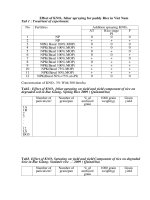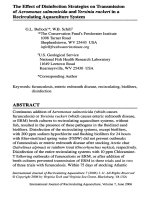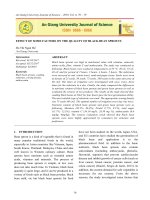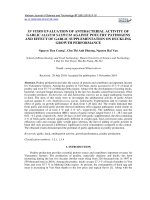Effect of plant extracts on root-knot nematode Meloidogyne incognita infecting tomato
Bạn đang xem bản rút gọn của tài liệu. Xem và tải ngay bản đầy đủ của tài liệu tại đây (240.44 KB, 6 trang )
Int.J.Curr.Microbiol.App.Sci (2019) 8(6): 373-378
International Journal of Current Microbiology and Applied Sciences
ISSN: 2319-7706 Volume 8 Number 06 (2019)
Journal homepage:
Original Research Article
/>
Effect of Plant Extracts on Root-Knot Nematode
Meloidogyne incognita Infecting Tomato
S.M. Vinodhini, T. Monisha, P. Praveen Arunachalam,
S. Rajshree, P. Vignesh, E.G. Ebenezar and N. Seenivasan*
Department of Plant Pathology, Agricultural College and Research Institute, Tamil Nadu
Agricultural University, Madurai 625 104, Tamil Nadu, India
*Corresponding author
ABSTRACT
Keywords
Tomato,
Meloidogyne
incognita, Plant
extracts,
Management
Article Info
Accepted:
04 May 2019
Available Online:
10 June 2019
The root-knot nematode, Meloidogyne incognita is a key pest on tomato cultivation
throughout the world. Eco-friendly technique for the management of M. incognita on
tomato is still lacking. Hence, studies were conducted to test the nematicidal potency of
leaf extracts of asparagus, white hibiscus, jasmine and Ixora plants against M. incognita
under in vitro and pot culture. Under in vitro condition juvenile mortality rate was higher
(49.4-90.2%) in asparagus treatment where as mortality rate was lower in Ixora treatment
(8.2-35.4%). Pot culture experiment on the efficacy of plant extract on M. incognita
revealed that the infection of root-knot nematode in terms of number of galls/plant was
lower in asparagus leaf extract treatment. In other treatments, the number of galls varied
from 33-57 / plant where as in control 100 galls/plant. Asparagus treated plants were taller
with long root system. It is concluded that leaf extracts of asparagus is having high
nematotoxic potential against M. incognita which can be recommended to tomato growers
for root-knot nematode control after testing under field situations.
damage on tomato in tropical and subtropical
agriculture. Affected plants are often dwarfed,
with small leaves. The infected tomato plants
also express day wilt symptoms i.e. wilted
appearance during day time and normal
appearance during night time. The root-knot
infected tomato express symptoms similar to
nutrient deficiency. Tomato infested by M.
incognita can lead to yield loss up to 80%
(Nagachandrabose and Baidoo, 2017).
Introduction
Tomato (Lycopersicon esculentum L) is the
world’s most important vegetable crop that
plays important role to meet nutritional
requirement of people throughout the world.
The fruits of tomato are also used in the
preparation of soup, salad, pickles, ketchup,
puree and sauces. Ripe tomato fruit has high
nutritive value being a good source of vitamin
A, B and C, potassium and minerals. Rootknot nematode Meloidogyne incognita is a
plant-parasitic nematode that causes serious
Management of nematodes in tomato can be
achieved chiefly by chemical method.
373
Int.J.Curr.Microbiol.App.Sci (2019) 8(6): 373-378
However, repeated application of chemical
nematicides is needed to get desirable
nematode control. Continuous application of
chemical nematicide can lead to pollution
problem and toxicity to non-target organism
(Seenivasan, 2017).
Materials and Methods
Culture of Meloidogyne incognita
A population of Meloidogyne incognita used
for in vitro and glass house studies, was
originally isolated from the tomato roots at
Fruit Orchard, Agricultural College and
Research Institute, Tamil Nadu Agricultural
University, Madurai, Tamil Nadu, India. A
single egg mass of M. incognita was collected
from the infected tomato roots, placed in a
Petri dish containing sterile water and allowed
to hatch for a week. The juveniles hatched out
were multiplied on tomato cv. Co 1 grown in
pots (5 kg capacity) containing sterile red
earth: sand: farmyard manure (2:2:1) mixture
in the glasshouse. After 8-10 weeks, eggs and
juveniles were collected from the infected
tomato roots by a modified NaOCl extraction
method (Hussey and Barker, 1973;
Seenivasan and Senthilnathan, 2018). The
entire root system was dipped in water and
soil was removed gently without detaching
egg sacs. Eggs were extracted by vigorous
shaking of infested roots in a 1% sodium
hypochlorite solution for 3 min. The resulting
suspension was then passed through a range
of deferent mesh-size sieves. The eggs were
collected on a fine sieve (350 mesh) and
washed in tap water to remove all traces of
sodium hypochlorite before use. Hatched
juveniles of M. incognita were obtained by
placing the eggs in sterile distilled water for 5
days at room temperature. The freshly
hatched juveniles (J2) were used for the
laboratory and pot tests.
In the recent years many bio-control agents
were tested against plant parasitic nematodes
including M. incognita on tomato. However
non-availability
of
their
commercial
formulations leads to restrict their usage by
farmers. Hence, the requirement of the day for
M. incognita control in tomato should be ecofriendly and locally available. Among the
various eco-friendly strategies available for
nematode management, application of
extracts of locally available plants is one of
the thrust idea need to be exploited for field
level application (Seenivasan, 2011).
The concept of plant origin bio-pesticides in
modern agriculture has now attained wider
applications than earlier. A large number of
plants/plant parts or their products have been
tested in-vitro for their nematicidal attributes
revealed that extractives of several plants
prepared in water or in organic solvents have
been found effective against several
economically important plant parasitic
nematodes (Thoden and Korthals, 2011).
However, little information is available on the
presence of the bioactive products present in
Asparagus, White hibiscus, Jasmine and Ixora
effective against plant-parasitic nematodes.
Hence, this study was conducted with the
following objectives viz.,
1) To study the direct mortality of M.
incognita when exposed to leaf extracts of
Asparagus, White hibiscus, Jasmine, Ixora,
and 2) To study the effect of amending the
soil with leaf extracts of Asparagus, White
hibiscus, Jasmine and Ixora on M. incognita
infection on tomato roots under pot
conditions.
Preparation of leaf extracts
Five g of leaves was taken in a conical flask
and 80 ml of methanol was added. It was kept
in the shaker overnight at 40°C at 130 rpm,
again 80 ml of methanol was added and kept
in shaker. This process was repeated for five
times to get leaf extract concentrate. The
374
Int.J.Curr.Microbiol.App.Sci (2019) 8(6): 373-378
in each pot and mixed thoroughly; T1 –
Asperagus extract; T2 - White Hibiscus
extract; T3 – Jasmine extract; T4 – Ixora
extract; and T5 - Untreated control. A
completely randomized design was adopted
with four replications for each treatment. Five
days after sowing, freshly hatched, juveniles
of M. incognita were inoculated in the root
zone at 500 J2/pot. The plants were carefully
uprooted after a month after inoculation and
the observations on number of galls, shoot
length and root length were made.
prepared plant extracts were used for in vitro
and pot tests.
Effect of plant extracts on second stage
juveniles (J2) of Meloidogyne incognita
To determine the effect of various
concentrations of plant extracts (25%, 50%
and 100%) on mortality of M. incognita
second stage juveniles (J2), 9 ml of each plant
extract concentrations was poured into small
petri dishes to which 1 ml suspension
containing freshly hatched J2 containing 20
J2 ml-1 was added. One ml of juvenile
suspension in nine ml of sterile distilled water
served as control. Each treatment was
replicated five times. For J2 mortality test, the
number of dead juveniles were counted after
48 h exposure and expressed as per cent
mortality. Nematode was considered dead if
they did not move when probed with a fine
needle.
The data collected from both studies were
analyzed and compared by t-test following
Panse and Sukhatme (Panse and Sukhatme,
1954).
Results and Discussion
Efficacy of Meloidogyne incognita in
different plant extracts under in vitro
conditions
Evaluation of plant extracts against M.
incognita
in
tomato
(Pot
culture
experiment)
It was observed that all the tested
concentrations of aqueous extracts (25%, 50%
and 100% or crude) viz., asparagus, white
hibiscus, jasmine, Ixora caused mortality of
M. incognita juveniles as compared with
control. However, mortality rate significantly
differed among tested plant extracts and even
within their concentrations. Extract of
asparagus was best among tested plant
extracts which recorded 90.2% mortality
while white hibiscus has mortality 74.3%,
jasmine recorded mortality of 50.4% and
ixora has mortality rate of 35.4% in crude
concentration (Figure 1).
The plant extracts of Asparagus, White
hibiscus, Jasmine and Ixora were tested
against M. incognita infesting tomato under
glasshouse conditions. Pot culture experiment
was conducted at the Department of Plant
Pathology, Agricultural College and Research
Institute, Madurai during February 2019 to
April 2019. Tomato seed PKM1 obtained
from Horticultural College and Research
Institute, Periyakulam was used in this
experiment. One month old tomato seedlings
from nursery pots were carefully uprooted,
washed thoroughly to remove the soil
particles and transplanted @ one/pot in 15 cm
diameter earthen pots containing steamsterilised pot mixture (Red soil: Sand:
Farmyard manure; 3: 2: 1) and maintained in
the glasshouse. At the time of sowing, the
following treatments were applied to the soil
At 50% concentration of the asparagus
extract, the maximum mortality of juveniles
(79.1%) was recorded. It was followed by
white hibiscus (48.4% mortality), jasmine
(35.6% mortality) and Ixora (15.5%
mortality). In 25% concentration, the extract
of asparagus has juvenile mortality of 49.4%,
375
Int.J.Curr.Microbiol.App.Sci (2019) 8(6): 373-378
white hibiscus recorded mortality of 23.5%,
jasmine recorded mortality of 14.7% and
Ixora recorded 8.2% of mortality (Figure 1).
of asparagusic acid was reported in seeds of
asparagus plants (Takasugi et al., 1975).
Results of our study also suggested that the
leaf of asparagus might possesses glycoside
like compound or asparagusic acid that might
be studied further to prove this hypothesis.
The results clearly evidenced that Asparagus
leaf extract is the best for managing M.
incognita than leaf extracts of white hibiscus,
jasmine and ixora. The major bioactive
constituents of Asparagus are a group of
steroidal saponins. Other primary chemical
constituents of Asparagus are essential oils,
arginine, tyrosine, flavonoids and resin and
tannin. The other bioactives principles are
sarsasopogenin and shatavarin 1-4 which are
present in leaves of Asparagus species. The
nematicidal properties of root exudates of
asparagus was first reported against the
stubby root nematode, Trichodorus christiei
[8]
. They proved that a low molecular weight
glycoside compound with aglycone is
responsible T. christiei mortality. The
asparagusic acid present in roots of asparagus
was reported to have nematicidal property
against several plant parasitic nematodes
(Rohde and Jenkins, 1958). Earlier studies
established that the compounds from
asparagus root exudates and acid from
asparagus root are responsible for nematode
control. This work will be the first to establish
the nematicidal properties of leaf extracts of
asparagus against M. incognita. The presence
Effect of plant extracts on galling of roots
of tomato inoculated with Meloidogyne
incognita under pot culture condition
The results revealed that lesser number of
galls was produced by Meloidogyne incognita
in the plants treated with Asparagus extract
which was significant over the other
treatments and the control (Figure 2). It was
also observed that infectivity of root-knot
nematode Meloidogyne incognita was not
inhibited much with Ixora extract treatment.
Earlier the root extracts of asparagus was
evaluated against M. incognita on egg plant
and results are in confirmatory with our
findings (Izuogu et al, 2012). To our
knowledge, this is the first report that
evidenced the negative effect of leave extracts
of asparagus on M. incognita infectivity on
tomato. The bioactive compounds present in
the leaf extracts of asparagus caused mortality
of M. incognita that affected the infectivity on
tomato plants. The results obtained in vitro
studies supports this hypothesis (Table 1).
Table.1 Effect of different plant extracts on growth of tomato challenge inoculated with
Meloidogyne incognita
Treatments
ASPARAGUS
JASMINE
WHITE
HIBISCUS
IXORA
CONTROL
CD at P=0.05
Shoot
length(cm)
17.8
10.3
13.7
% increase over
control
16.8
9.3
12.7
Root length
(cm)
8.4
5.7
6.3
% increase over
control
7.4
4.7
5.3
8.7
6.9
2.8
7.7
-
4.3
4.1
1.9
3.3
-
376
Int.J.Curr.Microbiol.App.Sci (2019) 8(6): 373-378
Fig.1 Mortality rate of root knot nematode Meloidogyne incognita when exposed to different
plant extracts under in-vitro condition
Fig.2 Infectivity of Meloidogyne incognita on tomato after treatment with plant extracts
Fig.3 Galling pattern in asparagus treated and untreated tomato plant roots
377
Int.J.Curr.Microbiol.App.Sci (2019) 8(6): 373-378
Science Publisher, New York, USA. pp. 217.
Panse, V.G. and Sukhatme, P.V. 1954. Statistical
Methods For Agricultural Workers. The
Indian Council Of Agricultural Research;
New Delhi..
Rohde, R.A. and Jenkins, W.R. 1958. Basis for
resistance of Asparagus offidnalis var. altilis
L. to the stubby-root nematode Trichodorus
christiei Allen 1957. Bulletin of the
Maryland Agricultural Experiment Station.
A-97.
Seenivasan, N. 2010. Biointensive management of
Meloidogyne incognita and Macrophomina
phaseolina disease complex in medicinal
coleus. Indian Journal of Plant Protection.
38(2): 186-192.
Seenivasan, N. 2011. Bioefficacy of anti-nemic
plants against root-knot nematode in
medicinal coleus. Journal of Ecofriendly
Agriculture. 6: 92-96.
Seenivasan, N. 2017. Management of Radopholus
similis and Helicotylenchus multicinctus in
ratoon banana grown under high density
planting systems. International Journal of
Fruit Science. 17(1): 41-62.
Seenivasan, N. and Senthilnathan, S. 2018. Effect
of humic acid on Meloidogyne incognita
(Kofoid & White) Chitwood infecting
banana (Musa spp.). International journal of
pest management. 64(2): 110-118
Takasugi, M., Yachida, Y., Anetai, M.,
Masamune, T. and Kegasawa, K. 1975.
Identification of asparagusic acid as a
nematicide occurring naturally in the roots of
asparagus. Chemistry Letters. 4(1): 43-44.
Thoden, T.C. and Korthals, G.W. 2011. Organic
amendments and their influences on plantparasitic and free-living nematodes: a
promising
method
for
nematode
management. Nematology, 13: 133-153.
The plants treated with Asparagus registered
the maximum shoot length (17.4 cm) and root
length (8.7 cm) (Figure 3). The profound
improvement in growth of tomato might be
due to low M. incognita infectivity in
asparagus treated plants. Similar results of
improved growth due to M. incognita
reduction
were
established
earlier
(Seenivasan, 2010).
From the findings of this research work, it can
be recommended that soil application of
methanol extracts of asparagus leaves can be
followed by the tomato growers to manage
root-knot nematode menace. It is a low cost
technology i.e. the farmer itself can prepare
asparagus leaf extracts as it is a common
garden land weed plant. This technology can
also become a replacement for the synthetic,
dangerous
and
expensive
chemical
nematicide. However, further efficacy tests
under field conditions are essential before
adoption by farming community.
References
Hussey, R.S. and Barker, K.R. 1973. A
comparison of methods of collecting inocula
of Meloidogyne spp., including a new
technique. Plant Disease Reporter. 57: 10251028.
Izuogu, N.B., Oyedunmade, E.E.A. and Usman,
A.M. 2012. Toxicity of aqueous and
powdered sparrow grass,
Asparagus
africanus to Meloidogyne incognita on egg
plant. IJOARD. 37.
Nagachandrabose, S. and Baidoo, R. 2017. A
Guide to Introductory Nematology. Nova
How to cite this article:
Vinodhini, S.M., T. Monisha, P. Praveen Arunachalam, S. Rajshree, P. Vignesh, E.G. Ebenezar
and Seenivasan, N. 2019. Effect of Plant Extracts on Root-Knot Nematode Meloidogyne
incognita Infecting Tomato. Int.J.Curr.Microbiol.App.Sci. 8(06): 373-378.
doi: />
378









